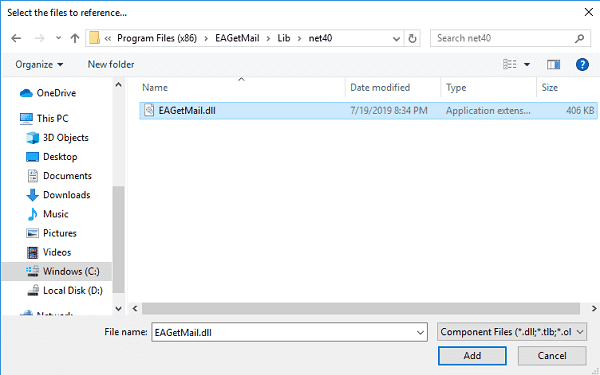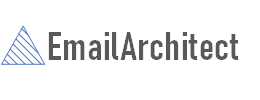Managed C++/CLI - Retrieve email from Gmail account¶
The following C++/CLI example codes demonstrate how to retrieve email from Gmail IMAP4 server.
Gmail POP3 and IMAP4 Setting
Gmail POP3 server address is pop.gmail.com. It requires SSL connection on 995
port, and you should use your Gmail email address as the user name for user authentication.
Gmail IMAP4 server address is imap.gmail.com. It requires SSL connection on 993
port, and you should use your Gmail email address as the user name for user authentication.
For example: your email is gmailid@gmail.com, and then the user name should be
gmailid@gmail.com.
To retrieve email from Gmail account, you need to enable POP3 or IMAP4 access in your gmail account settings.
Because Gmail POP3 server doesn’t work like normal POP3 server, it hides old emails automatically even the email was not deleted, so we suggest that you use IMAP4 protocol.
| Server | Port | SSL | Protocol |
| pop.gmail.com | 995 | SSL required | Pop3 |
| imap.gmail.com | 993 | SSL required | Imap4 (recommended) |
Gmail App Password¶
To help keep your account secure, starting May 30, 2022, Google will no longer support the use of third-party apps or devices which ask you to sign in to your Google Account using only your username and password.
Therefore, you should sign in using App Passwords.
An App Password is a 16-digit passcode that gives a less secure app or device permission
to access your Google Account. App Passwords can only be used with accounts that have 2-Step Verification turned on.
You need to use App Password instead of the user password for user authentication.
Another solution is Gmail OAUH, please see Gmail IMAP OAUTH section.
Last update: Google has disabled App password, you have to switch to Gmail IMAP OAUTH. If you don’t want to change your code, you can have a try with EA Oauth Service.
Installation¶
Before you can use the following sample codes, you should download the EAGetMail Installer and install it on your machine at first. Full sample projects are included in this installer.
Install from NuGet
You can also install the run-time assembly by NuGet. Run the following command in the NuGet Package Manager Console:
Install-Package EAGetMail
Note
If you install it by NuGet, no sample projects are installed, only .NET assembly is installed. And you also need to get a trial license code from here instead of using “TryIt”.
Add reference¶
To use EAGetMail POP3 & IMAP Component in your project, the first step is “Add reference
of EAGetMail to your project”. Please create or open your project with Visual Studio,
then go to menu -> Project -> Add Reference -> .NET -> Browse..., and
select Installation path\Lib\[netversion]\EAGetMail.dll, click Open-> OK, the reference
will be added to the project, you can start to use it to
retrieve email and parse email in your project.

.NET assembly¶
Because EAGetMail has separate builds for .Net Framework, please refer to the following table and choose the correct dll.
Separate builds of run-time assembly for .Net Framework 2.0, 4.0, 4.5, 4.6.1, 4.7.2, 4.8.1, .NET 6.0, NET 7.0, .NET 8.0, .NET Standard 2.0 and .Net Compact Framework 2.0, 3.5.
| File | .NET Framework Version |
| Lib\[net20|40|45|461|472|481]\EAGetMail.dll |
Built with .NET Framework 2.0, 4.0, 4.5, 4.6.1, 4.7.2, 4.8.1
It requires .NET Framework 2.0, 3.5 or later version. |
| Lib\[net6.0|7.0|8.0]\EAGetMail.dll |
Built with .NET 6.0, .NET 7.0, .NET 8.0
It requires .NET 6.0 or later version. |
| Lib\netstandard2.0\EAGetMail.dll |
Built with .NET Standard 2.0
It requires .NET Standard 2.0 or later version. |
| Lib\[net20-cf|net35-cf]\EAGetMail.dll |
Built with .NET Compact Framework 2.0, 3.5
It requires .NET Compact Framework 2.0, 3.5 or later version. |
Managed C++/CLI - Retrieve email from Gmail account - example¶
The following example codes demonstrate how to use EAGetMail POP3 component to download email from Gmail IMAP server.
In order to run it correctly, please change email server, user, password, folder, file name value to yours.
Note
To get full sample projects, please download and install EAGetMail on your machine.
Because Gmail POP3 server doesn’t work like normal POP3 server, it hides old emails automatically even the email was not deleted, so we suggest that you use IMAP4 protocol.
#include "stdafx.h"
using namespace System;
using namespace System::Globalization;
using namespace System::IO;
using namespace EAGetMail; //add EAGetMail namespace
// Generate an unqiue email file name based on date time
static String ^ _generateFileName(int sequence)
{
DateTime currentDateTime = DateTime::Now;
return String::Format("{0}-{1:000}-{2:000}.eml",
currentDateTime.ToString("yyyyMMddHHmmss", gcnew CultureInfo("en-US")),
currentDateTime.Millisecond,
sequence);
}
int main(array<System::String ^> ^args)
{
try
{
// Create a folder named "inbox" under current directory
// to save the email retrieved.
String ^localInbox = String::Format("{0}\\inbox", Directory::GetCurrentDirectory());
// If the folder is not existed, create it.
if (!Directory::Exists(localInbox))
{
Directory::CreateDirectory(localInbox);
}
// Create app password in Google account
// https://support.google.com/accounts/answer/185833?hl=en
// Gmail IMAP server is "imap.gmail.com"
MailServer ^oServer = gcnew MailServer("imap.gmail.com",
"gmailid@gmail.com",
"your app password",
ServerProtocol::Imap4);
// Enable SSL connection
oServer->SSLConnection = true;
// Set 993 IMAP4 SSL port
oServer->Port = 993;
Console::WriteLine("Connecting server ...");
MailClient ^oClient = gcnew MailClient("TryIt");
oClient->Connect(oServer);
array<MailInfo^> ^infos = oClient->GetMailInfos();
Console::WriteLine("Total {0} email(s)\r\n", infos->Length);
for (int i = 0; i < infos->Length; i++)
{
MailInfo ^info = infos[i];
Console::WriteLine("Index: {0}; Size: {1}; UIDL: {2}",
info->Index, info->Size, info->UIDL);
// Generate an unqiue email file name based on date time
String^ fileName = _generateFileName(i + 1);
String^ fullPath = String::Format("{0}\\{1}", localInbox, fileName);
// Receive email from IMAP server
Mail ^oMail = oClient->GetMail(info);
Console::WriteLine("From: {0}", oMail->From->ToString());
Console::WriteLine("Subject: {0}\r\n", oMail->Subject);
// Save email to local disk
oMail->SaveAs(fullPath, true);
// Mark email as deleted from IMAP server.
oClient->Delete(info);
}
// Quit and expunge emails marked as deleted from IMAP server.
oClient->Quit();
Console::WriteLine("Completed!");
}
catch (Exception ^ep)
{
Console::WriteLine(ep->Message);
}
return 0;
}
Gmail IMAP OAUTH¶
By default, you can generate an App Passwords, and use this app password instead of the user password for IMAP4 authentication.
However, Google will disable traditional user authentication in the future, switching to Google OAuth is strongly recommended now.
Managed C++/CLI - Retrieve unread/new email from Gmail account - example¶
Because IMAP/EWS/WebDAV support read mail flag, with this feature, we can also retrieve unread/new email only from Gmail like this
#include "stdafx.h"
using namespace System;
using namespace System::Globalization;
using namespace System::IO;
using namespace EAGetMail; //add EAGetMail namespace
// Generate an unqiue email file name based on date time
static String ^ _generateFileName(int sequence)
{
DateTime currentDateTime = DateTime::Now;
return String::Format("{0}-{1:000}-{2:000}.eml",
currentDateTime.ToString("yyyyMMddHHmmss", gcnew CultureInfo("en-US")),
currentDateTime.Millisecond,
sequence);
}
int main(array<System::String ^> ^args)
{
try
{
// Create a folder named "inbox" under current directory
// to save the email retrieved.
String ^localInbox = String::Format("{0}\\inbox", Directory::GetCurrentDirectory());
// If the folder is not existed, create it.
if (!Directory::Exists(localInbox))
{
Directory::CreateDirectory(localInbox);
}
// Create app password in Google account
// https://support.google.com/accounts/answer/185833?hl=en
// Gmail IMAP server is "imap.gmail.com"
MailServer ^oServer = gcnew MailServer("imap.gmail.com",
"gmailid@gmail.com",
"your app password",
ServerProtocol::Imap4);
// Enable SSL connection
oServer->SSLConnection = true;
// Set 993 IMAP4 SSL port
oServer->Port = 993;
Console::WriteLine("Connecting server ...");
MailClient ^oClient = gcnew MailClient("TryIt");
oClient->Connect(oServer);
// retrieve unread/new email only
oClient->GetMailInfosParam->Reset();
oClient->GetMailInfosParam->GetMailInfosOptions = GetMailInfosOptionType::NewOnly;
array<MailInfo^> ^infos = oClient->GetMailInfos();
Console::WriteLine("Total {0} unread email(s)\r\n", infos->Length);
for (int i = 0; i < infos->Length; i++)
{
MailInfo ^info = infos[i];
Console::WriteLine("Index: {0}; Size: {1}; UIDL: {2}",
info->Index, info->Size, info->UIDL);
// Generate an unqiue email file name based on date time
String^ fileName = _generateFileName(i + 1);
String^ fullPath = String::Format("{0}\\{1}", localInbox, fileName);
// Receive email from IMAP server
Mail ^oMail = oClient->GetMail(info);
Console::WriteLine("From: {0}", oMail->From->ToString());
Console::WriteLine("Subject: {0}\r\n", oMail->Subject);
// Save email to local disk
oMail->SaveAs(fullPath, true);
// mark unread email as read, next time this email won't be retrieved again
if (!info->Read)
{
oClient->MarkAsRead(info, true);
}
// if you don't want to leave a copy on server, please use
// oClient->Delete(info);
// instead of MarkAsRead
}
// Quit and expunge emails marked as deleted from IMAP server.
oClient->Quit();
Console::WriteLine("Completed!");
}
catch (Exception ^ep)
{
Console::WriteLine(ep->Message);
}
return 0;
}
TLS 1.2 protocol¶
TLS is the successor of SSL, more and more SMTP servers require TLS 1.2 encryption now.
If your operating system is Windows XP/Vista/Windows 7/Windows 2003/2008/2008 R2/2012/2012 R2, you need to
enable TLS 1.2 protocol in your operating system like this:
Enable TLS 1.2 on Windows XP/Vista/7/10/Windows 2008/2008 R2/2012
Appendix
- Retrieve email and parse email in Managed C++/CLI - Tutorial
- EAGetMail POP3/IMAP4 Component SDK
- Using UIDLManager to mark email as read/downloaded
- Download only unread/new emails from IMAP or MS Exchange Server
- Search emails and filter emails on IMAP or MS Exchange Server
- Retrieve emails from specified folder in IMAP or MS Exchange Server
Comments
If you have any comments or questions about above example codes, please click here to add your comments.
